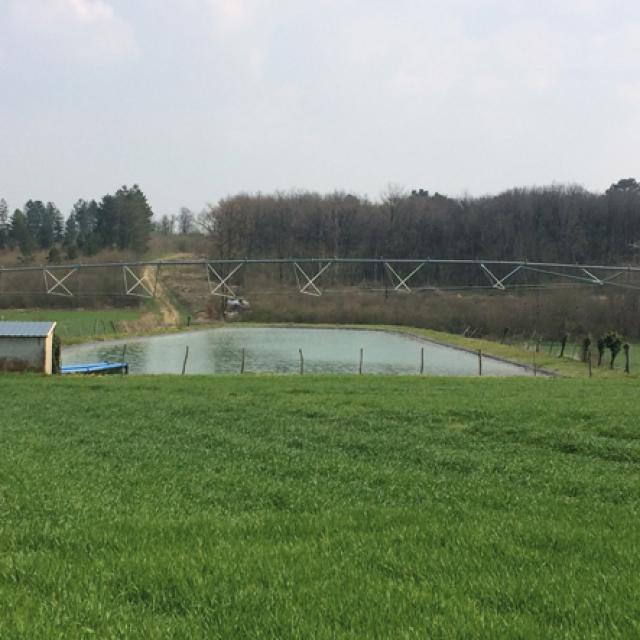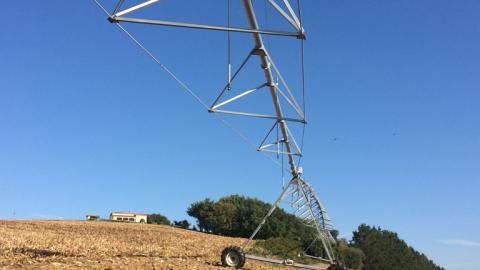Mr. Reinier, a farmer in the Vienne region, owns a non-organic medium-sized farm of 160 hectares. He has 80 hectares of wheat, 50 hectares of barley, 13 hectares of popcorn maize and 10 hectares of peas. The whole of the farm is irrigated, with two pivots and two hose reels being used.

I travelled to Mr. Reinier’s farm on a beautiful April morning, accompanied by Armel Morlet, head of sales at Valley, and Mr. Dousselain, a distributer of irrigation equipment from Leblanc in the Vienne. Mr. Reinier welcomed us at the farm. We got back in the car and went to the field that was of interest to us.
Right in the middle of a 27-hectare field we spotted a large water catchment reservoir. The aim of the hillside catchment dam is to recover the rainwater and non-drinkable runoff and reuse it. It is also, and above all, supplied by a 160 m3 per hour borehole, which is 73 metres deep, but often the water table level rises to 42 metres because there is an underground stream. The groundwater is always accessible and Mr. Reinier has no problem with water availability. Two pumps feed the farm’s two pivots. According to Mr. Morlet, “agriculture requires water, it is borrowed for a while and then returned to nature, in accordance with the natural cycle”.
In the Vienne and Poitou Charente regions many famers have asked the authorities to build hillside catchment dams, but they have not received the necessary permission. This type of decision is very political. On the other hand, in the Vendée region, in the Villiers area, many catchment dams have been created.
A pivot with high clearance so as to be able to pass over the top of the large water catchment reservoir
The problem facing Mr. Reinier is how to irrigate a sloping field with a 4-metres high water catchment dam in the middle. Previously, he used to irrigate the field in question with a hose reel but it was very restrictive because it had to be moved around. “I was shifting the hosereels for 30 years because no-one came up with the idea of having pivots that cleared the height of the reservoir”, explained the farmer. He has spent 15 years on the project and 8 years ago, Mr. Reinier went to the Futuroscope irrigation show. He came across a pivot manufacturer who told him that there existed high clearance pivots used mainly on tree crops and to irrigate sugar cane. The manufacturer in question could not provide this type of product so Mr. Reinier turned to Valley who offered high-clearance pivots in their catalogue.
The pivot was assembled in 2012 and the installation process was quite long. It includes 6 spans which are higher than those of a standard pivot, with the span in the middle being even higher than the others (it has a span clearance of 4.90 metres).
Lamps have been added to the towers. In fact, a footpath runs across the field and, as the pivot operates at night, Mr. Reinier was forced to fit warning lights in case there should be people walking across the field.
Furthermore, the pivot has double pressurised intake pipes; the nozzles in the centre are higher so that they don’t drag on the ground. The sprinklers are of the I-Wob type from Senninger. On the farm’s second pivot located on the other side of the wood, assembled by Valley in 2000, Mr. Reinier has installed Nelson’s Rotators.
For the remainder of the farm he has two hose reels but he is currently considering whether it is worthwhile acquiring a third pivot and hopes that it materialises. In this case, he would only keep one hose reel.
The farmer mainly uses the well water but he also draws water from a river from October to March.
How the seasons evolved
Mr. Reinier has been growing maize in this field for 7 seasons, but this year he is going to grow barley “because the soil is fatigued, so it has to be given a rest. The prices are not there either.” It is, above all, the cost of electricity that poses a problem. In fact, the production costs for maize are €150 per tonne in France, whereas some countries, such as the Ukraine, can produce it for €80 per hectare. There are farms in the Ukraine of 4,000 hectares. It is difficult to respond to this scale of competition.
Thus, our farmer had to find another cereal to grow. “In the Loiret, they have contracts for growing vegetables, but it’s more complicated here.” In fact, the clayey and stony nature of the soil in Vienne is not suitable for vegetable production. “We are stuck with cereals”, he explained. And he continued: “Barley needs to be irrigated less than maize (corn). It is currently at the node detectable stage. We will soon be giving it a first run (of the pivot), then a second run will be sufficient for the grain filling stage”. The barley will be harvested on 25th June and in early August, Mr. Reinier will be planting the rape seed. He will only irrigate if it doesn’t rain.
M. Reinier said to Mr. Dousselain, his dealer: “We are going to have to get started again next week because it is very dry. They forecast some rain for Thursday but it won’t be enough. I am going to have to start the first run with an application of thirty millimetres”. And he added: “We’ll have to put the drain plugs back in. And there could be two or three nozzles that are blocked”. It was Mr. Dousselain who sold the pivots to our farmer. He offers an all-inclusive installation service and then monitors the farmers very closely. The after-sales service is personalised and customised. Mr. Dousselain set up his business in 2007 and currently has 150 to 200 customers such as Mr. Reinier.
Irrigation has become essential because the summers are becoming hotter and hotter. Once he starts irrigation, for maize (corn) in particular, Mr. Reinier will not stop until September. Previously, it was only a matter of applying one supplementary irrigation because we used to have thunderstorms from 14th July until somewhere around 15th August, but these are becoming less and less frequent. “Irrigation acts as a kind of insurance and it will add value to my farm if I ever decide to sell”, explained Mr. Reinier.

